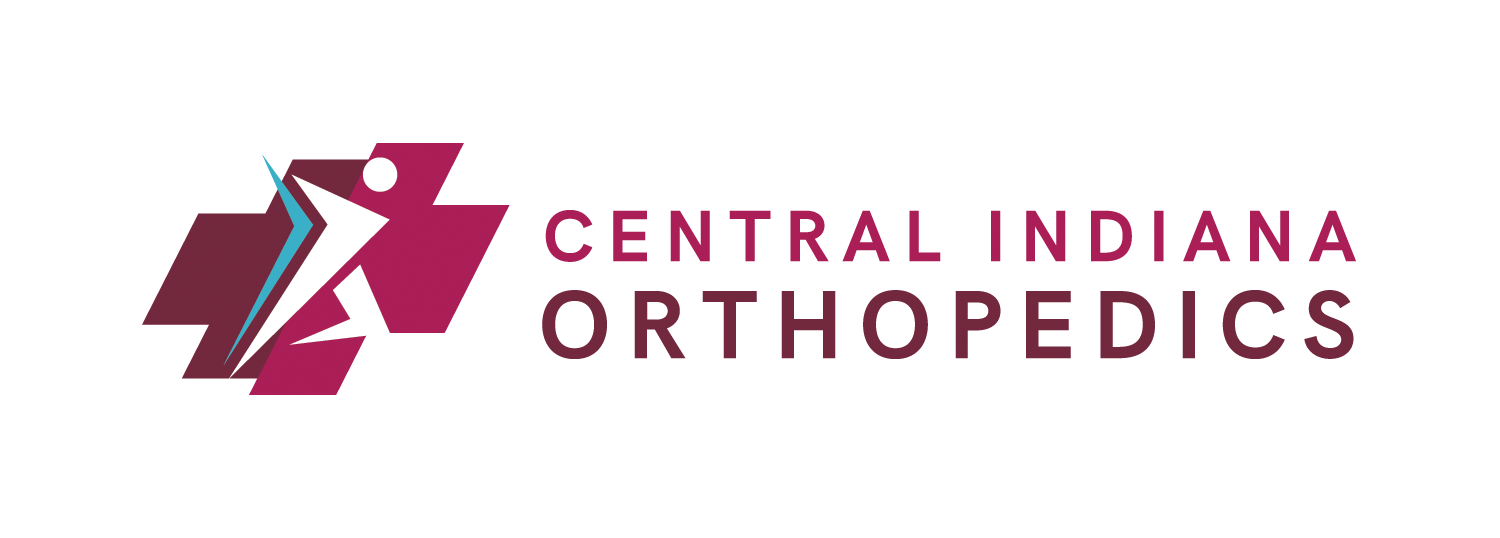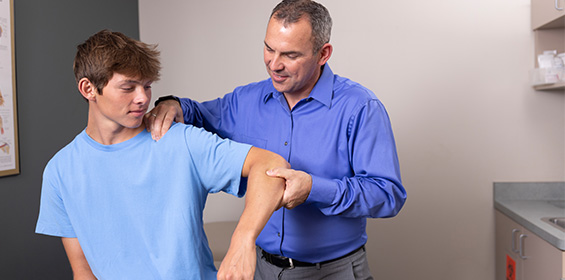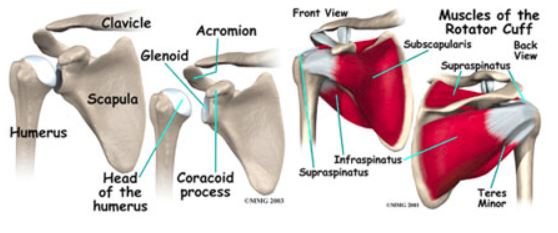Shoulder pain is a common musculoskeletal problem among patients today, with one of the most common causes of shoulder pain involving the rotator cuff. Approximately 2 million people in the US are diagnosed with a rotator cuff problem each year, which is why it’s so important for patients to be able to identify common symptoms, as well as potential treatment options, for rotator cuff tendon inflammation and tears.
Shoulder Anatomy
The shoulder is made of three bones: humerus, scapula and clavicle. These bones are held together with a series of ligaments, tendons and muscles to form the shoulder joint, a ball-and-socket joint where the ball is larger than the socket. This unique structure allows for more motion but less stability of the joint; therefore, the rotator cuff muscles and tendons are essential in holding the ball into the socket, and also aid the shoulder with rotation and elevation of the arm.
Figure 1. Normal shoulder anatomy. Rotator cuff muscles/tendon: Supraspinatus, infraspinatus, teres minor and subscapularis
Shoulder Injuries
There are three types of injuries to the rotator cuff tendons: tendinitis, partial tear or full thickness tear. Tendinitis means that there are no tears of the rotator cuff tendons, but the tendons are aggravated and inflamed. Partial tears (or incomplete) mean that the tears are damaged, but not completely severed. Full thickness (or complete) tears imply that there is a hole going through the tendon or that it is detached from the humerus completely.
Figure 2. (Left) Normal rotator cuff. (Right) Full thickness rotator cuff tear.
Risks Factors for Shoulder Injuries
Most rotator cuff tears are from normal wear and tear associated with aging. Patients greater than 40 years old are the most common patients with rotator cuff tears, as well as patients performing repetitive work or overhead activities. Regarding younger patients, it is more common to have rotator cuff tendinitis associated with athletes rather than large tears; however, an athlete with a traumatic fall or collision (e.g. football, hockey) should be evaluated for rotator cuff injuries, among other things.
Shoulder Injury Symptoms
The most common symptom of a rotator cuff injury includes pain along the outside portion of the shoulder. Significant weakness in raising the arm overhead can be another symptom to look for, but this is not a requirement for rotator cuff tears. Overhead activity and rotating the arm can reproduce the pain, as well as pain at night while asleep. Keep in mind that there can be other causes of pain that can mimic rotator cuff symptoms, including neck pain, nerve pain and even atypical heart attacks can be similar to rotator cuff pain, so it’s important to be evaluated by an orthopedic physician when these symptoms occur.
Shoulder Injury Treatment
While there are a variety of treatments for rotator cuff injuries, treatment should be individualized for each patient. Age, general health, activity requirements, work demands and social/family demands should all be considered in designing a treatment plan for all patients. Nonoperative treatment can be successful in treating about 70-80% of all rotator cuff injuries. These treatments include rest, activity modification (avoiding activities that cause pain), NSAIDs (over-the-counter medications such as ibuprofen or naproxen), rehab exercises performed with a therapist or at home and steroid injections. The primary advantage for nonoperative treatment is that it avoids surgical risks such as anesthesia complications, stiffness, infection and a lengthy recovery. The disadvantage is that while tears can become asymptomatic, it is uncommon for them to heal, and the size of the tear may increase over time.
If surgery is required, each surgeon has a different philosophy regarding their approach to rotator cuff tears. Most surgeons will try to identify the tear using a minimally invasive surgical approach called shoulder arthroscopy, or “shoulder scope.” During the procedure, an orthopedic surgeon makes small incisions at the shoulder and inserts a small camera called an arthroscope, as well as other surgical tools, to perform the procedure and examine the inside of the shoulder joint. Arthroscopy is commonly performed in an outpatient setting, allowing patients to go home the same day. Patients typically experience less pain and a quicker recovery with an arthroscopic procedure, in contrast to open surgery. Full recovery can take up to 4-12 months depending on the size of tear and the surgical requirements needed to fix it.
When to Schedule an Appointment
If you experience symptoms of a rotator cuff injury, it’s important not to delay treatment. At Central Indiana Orthopedics, our board-certified and fellowship-trained shoulder physicians work with each patient to evaluate the injury or pain and develop an individualized treatment plan with the patient’s lifestyle and goals in mind. To learn more about our shoulder team, visit ciocenter.com/services/shoulder/, or call 800-622-6575 to schedule an appointment.
References
https://orthoinfo.aaos.org/en/diseases–conditions/rotator-cuff-tears/
https://www.uclahealth.org/ortho/shoulder



